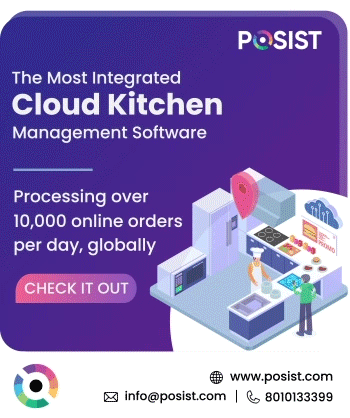Manvendra Solanki, professionally, a business management graduate entered the F&B industry soon after college. He started with his first venture after college but due to lack of experience and expertise, he had to close down the venture. This did not stop him from challenging himself. Out of sheer love for food, Solanki was determined to start his own food venture once again and that is how he started with the Spice Nation. Spice Nation is a multi-cuisine restaurant along with a banquet in Manjalpur, Vadodara.
In Conversation With Manvendra Solanki of Spice Nation
In an exclusive conversation with The Restaurant Times, Manvendra Solanki talks of his journey in the industry, the story behind Spice Nation, challenges while running the business, marketing strategy and a lot more.
About Spice Nation
After learning from past failure, Solanki was able to climb up the ladder and start with his new food venture, Spice Nation. His past experience and learnings helped him majorly to start with Spice Nation. It is a family restaurant cum banquet hall. The venue has a cosy ambience which makes everyone feel welcomed. Spice Nation Banquet, Vadodara is an elegant venue to host all your social events, pre-wedding functions, anniversaries, birthday parties, intimate weddings, and reception ceremonies. Be it an intimate affair or an extravagant celebration, this venue has a perfect location and capacity to fit all your requirements. It can accommodate up to 200 guests in seating and 300 guests in floating. Scrumptious vegetarian delicacies are offered by the Spice Nation Banquet, Makarpura, Vadodara that will satiate your taste buds.
Spice Nation being a family restaurant is a perfect place for all age groups. Apart from the banquet hall, they have outdoor catering services, kitty parties on their terrace garden and also affordable corporate lunch packs.
Merits Of Operating In Tier II City
Opening a food joint in Tier ll city can have significant advantages that could lead to exponential growth for the business. The two major advantages which restaurants in Tier ll city get in comparison with one in more developed cities are that of real estate property prices for setting up the restaurant and the competition in the market.
The real estate prices of Tier ll cities are typically lower than the prices found in larger, more developed cities. The less you spend on real estate, the more money you can spend on building your restaurant. This acts as an advantage for the restaurateur in a Tier ll city, unlike for a restaurateur in a more developed city wouldn’t have this advantage.
The second advantage is the restaurant competition. A restaurateur in a Tier ll city can capture a large percentage of the area’s restaurant business and create a large group of loyal customers. Even if other competitors come to the town, they will still have the first-mover advantage because of their timing.
Challenges Faced While Running The Business
During Solanki’s first venture, he had to face a lot of challenges due to the lack of first-hand experience.
According to Solanki, staff recruitment was always a major issue. Recruiting the right staff is essential for any business. They are the most valuable assets of your business who generate revenue for you. The staff at the restaurant are the face of the restaurant. They are the ones who interact with the customers directly. Solanki had to do a lot of background research before hiring anyone.
Secondly, in the initial stages, the vendors would deceive him by charging extra than the regular prices in the market for the raw materials. Solanki being new in this field didn’t know the exact market prices and ended up paying extra every time.
‘After sometime when I actually got to know the ground market price, I realized I was spaying extra all this while,’ says Solanki.
Thirdly, there was no option of generating Kitchen Order Tickets for kitchen management. Without the generation of KOT, it becomes time-consuming and open to manual errors.
Having a restaurant KOT which is automated, reduces the extent of manual mistakes, conserves time, helps you to have a real-time recording of all the orders at your restaurant, and reduces financial miscalculations.
It has become an indispensable part of streamlining restaurant operations and has become an absolute must for running the business seamlessly.
Third-party Food Aggregators
With Digital India, technologies are rapidly changing the food delivery industry. More and more customers are using apps and websites to order their food. Food delivery apps rose to cater to the needs of customers to have all cuisines and local restaurants in one place, ready to be delivered to them with one click. Solanki tells that the third party food aggregators are a blessing in disguise for them.
“Initially, before the coming of the third party food aggregators, the delivery orders would only be around 20 per day. But now with Swiggy, Zomato, UberEats, the orders have risen up to 80 per day,” says Solanki.
Food delivery apps are also useful to restaurant owners. They lower the cost of entering the delivery market for restaurants. They allow restaurants to have all food delivery operations outsourced and get over with. And finally, they are helping restaurant owners to reduce the costs of drawing more customers to their establishments. However, this aid is not offered for free. They charge certain commissions for their profit as well.
According to Solanki, these food aggregators take away a certain margin of the total but in return, they give volumes of orders.
Online food delivery and dine-in aggregators give various discounts and offer to its customers. This might distort the market and hurt the business for the restaurants.
Discounts are undoubtedly a privilege for the customers but it’s a choice for the restaurateurs says, Solanki.
Even if online delivery partners charge unreasonably high commissions, payment terms and arbitrarily applied additional charges, restaurateurs have an option of not tying up with these partners. Solanki tells that only those restaurants should opt for such tie-ups who can afford such expenses at the cost of orders.
“In a small city like Vadodara, till a few years back there were many restaurants who were on the verge of shutting down until these food ordering and membership-driven platforms came into force. This helped them immensely to increase their customer base through orders and survive in the industry,” says Solanki.
Marketing Strategy For Successful Restaurant Management
Sustaining a restaurant can be a continuous battle. The restaurant industry is a really tough industry to be in. In order to be on the top, great ambience and service are not the only details to be kept in mind. Marketing of your restaurant is an essential step to popularise your brand and gain new customers.
Solanki tells that there were no multi-cuisine restaurants in Manjalpur earlier. Patrons had to visit other places just to have different cuisines. Solanki felt the need of coming up with a multi-cuisine restaurant in Manjalpur to cater to the patron’s needs. Initially, to market his restaurant, he came up with an internal loyalty program for his customers, wherein various discounts and offers were offered to their regular customers. This is how he established his customer base.
‘Vadodara is an industrial location. A lot of corporates go out for lunch. The lunch offered is not really great. We made a tie-up with Groupon and offered budget-friendly lunch deals through coupons and discounts to the customers,’ says Solanki.
Apart from this, the Spice Nation has a presence on both print media and social media.
Especially during festivals, they have hoardings, counters, and specials for every department on the menu. This also helps them in imprinting their own brand.
For social media, they make sure that they post at least ten to fifteen image or video every month to attract customers. It helps them to make the customer aware of the specials and ongoing offers, if any, in the restaurant.
Technology Bedding
According to Solanki, technology is the backbone to enable restaurant discovery and a friction-less experience to guests. Initially, restaurant point of sale was just about processing sales.
Modern restaurant POS systems provide a platform that sits at the centre of any food and beverage operation, large or small, helping to enhance the customer experience and streamline business operations. Today’s integrated POS offers reports and analytics, stock and inventory management, CRM and a lot more.
Initially, Solanki was using his own software which was used for basic inventory management and bill generation. But with the new age modern POS system, Solanki’s human dependency has reduced a lot. He has been using Posist in his outlet for the past five months now.
“Posist has not only helped in reducing manual labour but also helped to reduce the margin of error and trace the records efficiently. Especially, when you have a banquet as well to manage, it makes the operations easier. The best part about Posist is the online order integration, it automatically generates the KOT and records it for future purposes. All the reports and analytics are available department wise for future reference as well,” says Solanki.
Solanki concludes by saying it is imperative to have a system based business, where everything is automated. It helps to save a lot of time and makes the day to day operations simpler. For example, having a standardized recipe through recipe management feature in the POS, it not only helps to use the raw materials efficiently but also maintains consistency in the products.


















